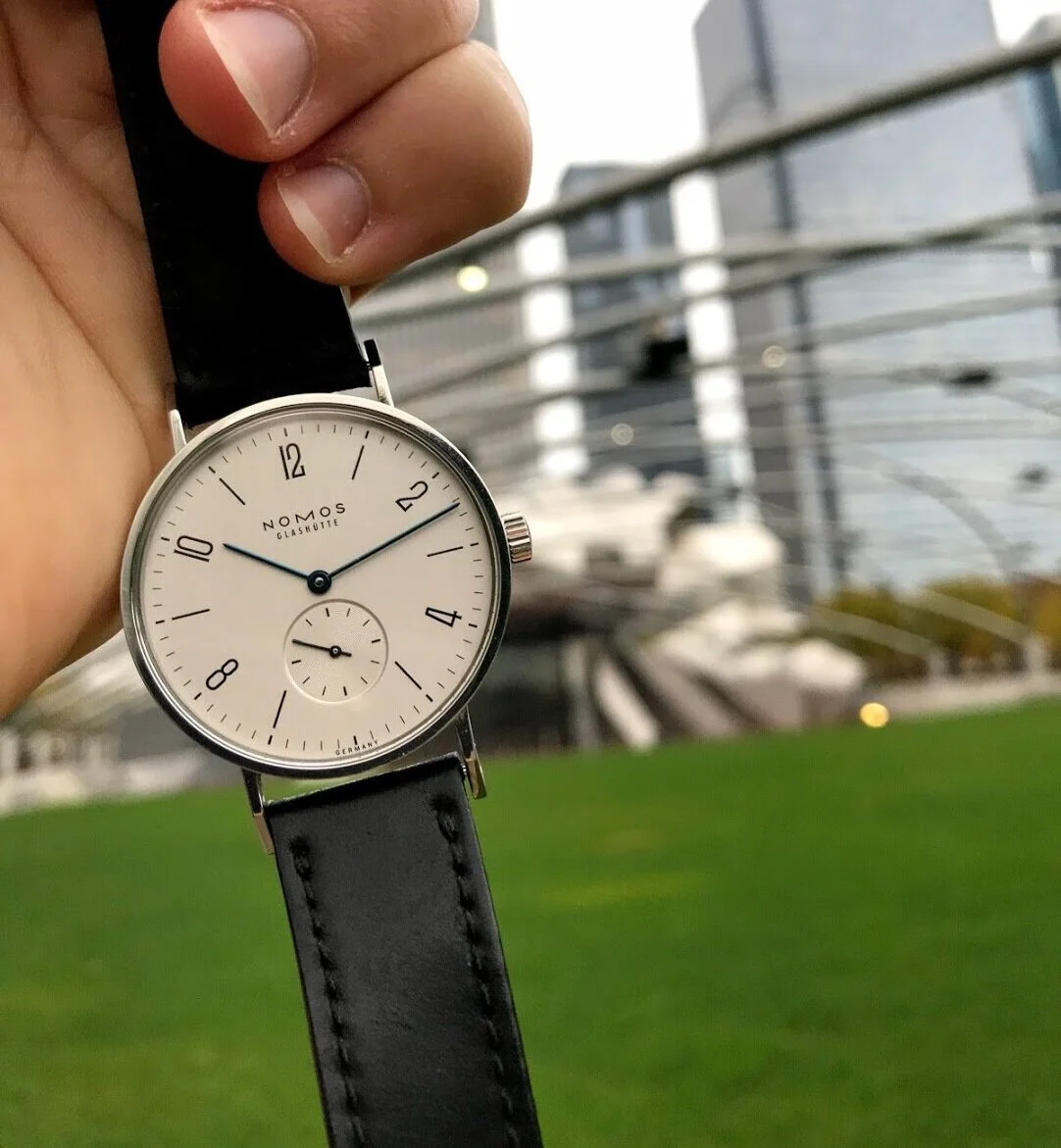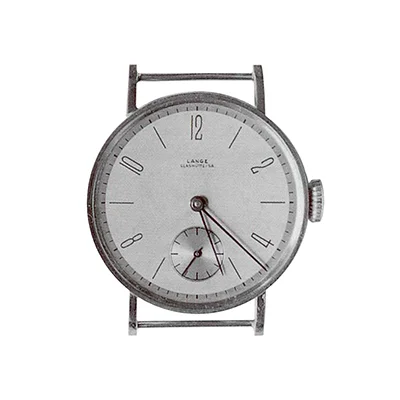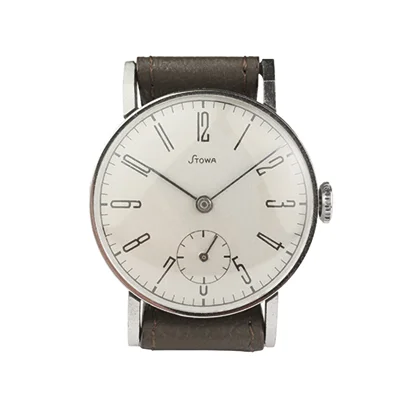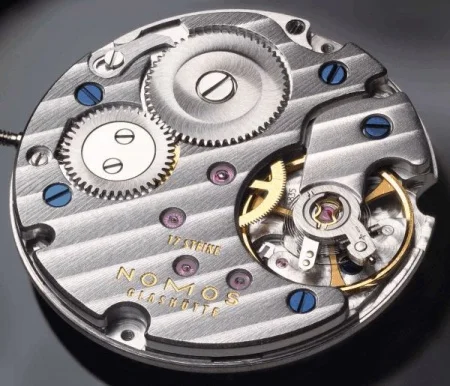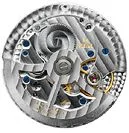I hate “brand histories” that are really just repeated PR fluff from the brand itself. But full disclosure: I absolutely love Nomos. The combination of in-house movements, relative affordability and that minimalist, Bauhaus aesthetic seemed perfectly attuned to my millennial sensibilities when I first got into watches a few years ago. Nomos make legit watches, almost completely in the small town of Glashütte, Germany, with a minimal, form-follows-function design that other brands could only dream of executing half as well.
This article will attempt to provide a brief history of the German watchmaker. The good, the bad, and what’s next.
A note on spelling: Glashütte is often English-ized into either “Glashuette “ or “Glashutte”. I’ll probably just refer to the brand as Nomos for the rest of the article, but wanted to put the other spellings in here — for the SEO, baby.
Another note: “Nomos” means law in Greek.
Nomos: Founding and History
Nomos is an independent German watchmaker, based in Glashütte, Saxony, Germany. The small town of 7,000 is squeezed into a valley about 2 hours south of Berlin, and is dotted with almost a dozen watchmakers and manufacturers, including A Lange & Sohne and Glashütte Original. While A Lange has the highest revenue of the Glashütte manufacturers, Nomos delivers the most watches. Today, Nomos is a member of the Deutscher Werkbund, an association of German artists, architects and designers. Founded in 1907, it helped give rise to the Bauhaus movement and associated design ethos of the early- to mid-1900s.
Nomos was founded by Roland Schwertner in January 1990 — a photographer and computer geek with no watch experience — just two months after the fall of the Berlin Wall. It was founded at the same time as the modern A Lange & Sohne, and Glashütte watchmaking began to experience a renaissance that persists to this day, even as the Swiss watch industry has struggled at times. While A Lange has been owned by Richemont Group and Glashütte Original has been owned by Swatch Group since 2000, Nomos remains an independent manufacturer — one of the few true independents in the watchmaking world, and perhaps the only independent making watches at prices accessible to the general public (Patek Phillipe, Audemars Piguet, F.P. Journe, and other small haute horology operations dot the list of independent manufacturers; this also includes other Glashütte watchmakers like Moritz Grossman). Like A Lange, the Nomos name had existed before, but only for a short run in the early 1900s.
The Nomos headquarters — home to most of the company’s 300 employees — is a converted train station in an idyllic little spot in Glashütte, adjacent to A Lange, Glashütte Original and not far from the town’s other watchmakers (you can walk across the entire town in about 15 minutes). The rest of the company’s employees work at the brand’s in-house creative studio, Berlinerblau, in central Berlin.
For a watch to stamp itself with the coveted “Glashütte” name, at least 50 percent of its value must be produced locally, a feat that Nomos too years to achieve as it worked to move its movement manufacturing in-house and away from ebauche movements.
Nomos factory in Glashütte, Germany
The Nomos boutique in Glashütte
Glashütte from the train platform. From left: Glashütte Original, A Lange, and Nomos
Nomos’ First Collection and the Tangente
Nomos launched its first collection in 1991, featuring the Orion, Ludwig, Tetra, and Tangente. All were designed by Susanne Gunther and featured a similar aesthetic: clean, minimal, Bauhaus. All of the models also hit a size sweet spot for both sexes: 35mm for the round models (the square tetra is 29.5mm), feeling almost reactionary to the gaudy two-tone watches that defined the eighties. Here though, Nomos proved ahead of its time: making watches that either sex could just as comfortably wear, with gender-neutral marketing to boot is a formula that some brands still have yet to master.
The collection’s success was led by the Tangente: a 35mm round watch with the most classical Bauhaus inspiration of the group. The watch was heavily inspired by the first Bauhaus watches of the 1930s: the first Stowa Antea and the first Bauhaus-style watch from Lange were both released in 1937. Look at that Lange (below) — it’s almost a dead ringer for the modern Nomos Tangente, especially their “100 years of Bauhaus” edition (and props to Stowa for cataloging the history of Bauhaus watches):
Am I the only one who thinks a modern watch like this from Lange would sell like crazy?
Just as the Tangente was an imitation of earlier Bauhaus-style watches, the success of the Tangente has aspurred another generation of imitators, from online direct-to-consumer imitators selling cheap quartz pieces to true luxury watch competitors. This is something to love and hate: you’ll get a ton of compliments on your Nomos from non-watch nerd friends, but they’ll also drop something like “wow, it looks like a slightly more sophisticated MVMT watch.” Barf.
Off the back of this success, Nomos took on an investment from a German retailer to help expand the brand. With the investment, Nomos took on the ambitious project of developing its own in-house movement. By 2003, Nomos bought back the shares it sold to the partner, again becoming a completely independent company.
Nomos Movements: Going In-House
From its launch in 1992 through early 2005, Nomos used Swiss ETA or Peseux ebauche movements. The movements were based on the Peseux 7001, though with some finishing done in Glashütte style: Solar grinding on the crown and barrel wheels, "Glashütte stripes on the bridges, and blued screws. The plates were also rhodinated to become resistant to oxidation and later blasted and gilded.
Due to these modifications, ETA requested that Nomos not use their name on the movement as early as 1997, so Nomos began re-working the movements even more. In March, 2002, the company gave this modified calibre a new name: Nomos 1 T. This calibre replaced the plate and balance cock of the Peseux with gold plated pieces decorated with perlage at the Nomos facility. Regulation was now done using Triovis fine regulation, thus the "T" in the name. The next major shift was the introduction of the Nomos 1 TSP and its descendants, which featured Glashütte style three-quarter places.
Finally, in 2005, Nomos released its first watch with an in-house movement: the Tangomat. At the same time, the Tangente’s manual movement was also converted to an in-house manufacture. Nomos was finally doing much greater than 50 percent of its watchmaking in Glashütte, and could justifiably join the ranks of genuine Glashütte manufacturers.
The Nomos Epsilon was the first self-winding movement (in the Tangomat), and the Nomos Alpha (in the Tangente) the first manual movement:
Left: Nomos Alpha movement | Right: Nomos Epsilon movement
Both movements feature three-quarter Glashütte plates, hacking seconds, Glashütte stripes, tempered blue screws, rhodium plated surfaces with stripes and “Nomos” perlage, and the "Glashütte” sunburst around the crown wheel. The movements still used an externally soured escapement and would continue to until 2014.
In 2013, Nomos introduced a new line of calibres, called “Deutsche Uhrenwekre” (DUW), meant to signify Nomos’ increased capacity as a manufacturer in its own right.
Then, in 2014, Nomos announced that it had developed a completely in-house escapement: the Nomos Swing System. Nomos introduced its completely in-house movement at Baselword 2014 with the launch of the Metro. Manufacturing the Swing System is an incredibly precise process, and to this day, only a few watchmakers at Nomos are capable of properly executing the process. Not only was the movement a noteworthy achievement for the brand; the design itself was lauded by watch enthusiasts and designers around the world. Designed by legendary industrial designer Mark Braun, the Metro was a colorful break from some of Nomos’ more staid designs. It somehow conjures up images of the 1930s just as well as it does the 2330s.
Today, Nomos produces 13 movements in house. In addition to the original alpha and epsilon movements, highlights include:
DUW 1001 - Round, 29 jewel, double barrel, hand-wound, power reserve indicator
DUW 5101 automatic, date function, 42-hour power reserve (used in a number of date models, including the Club, Ahoi, and Tangomat)
DUW 5201 automatic world timer, 42-hour power reserve (used in the Tangomat GMT and Zurich Worldtimer)
DUW 2002 manual winding with 84-hour power reserved (used in the Lux collection)
In 2015, Nomos introduced the DUW 3001, an automatic movement that, while just 3.2 mm thick, also manages to maintain time extremely accurately and efficiently. It features in the new Nomos Minimatik, a new model that, with its softly curving lugs, stands out from other Nomos designs. The DUW 3001 also features in Nomos’ ever-expanding Neomatik line, which refreshes classic Nomos designs with new colors and accents.
Nomos Minimatik, featuring the DUW 3001
Like the original in-house Alpha and Epsilon movements, all of Nomos’ calibres are highly decorated with Glashütte stripes, rhodium plating, perlage, sunburst decoration, and the other details you’d expect from a luxury watchmaker of this caliber. Most watches are also offered with a sapphire exhibition caseback option, so you can admire the beautifully finished movements on the daily. Sure, it’s not exactly “Bauhaus,” but they make movements truly worthy of gawking.
A Nomos Alpha calibre, seen through the exhibition caseback of a Tangente.
Nomos: Not Without Controversy
Nomos Metro Silvercut, from the “At Work” collection
In 2017, Nomos introduced its “At Work” collection. The watches are meant to be daily wearers for the modern professional. All 14 watches in the collection are equipped with the ultrathin Neomatik automatic movement. The collection includes updates to the Metro, Tangente, Orion, and Tetra in three different dials, including a sexy new Silvercut. The At Work collection also sized up all the models to 39mm in diameter, substantially larger than Nomos’ traditional 35mm size. Some pointed out that this seemed to imply that only those with larger wrists (i.e. men) were actually “at work”. It was an unfortunate slip up by a brand that has often been praised for blurring the lines between what a “men’s” or “women’s” watch should be. The 35mm size of the original models works equally well on men and women, and the minimalist, inoffensive designs can work with most aesthetics.
Nomos has arguably fallen into the same trap with its marketing of the Nomos Club collection. The Club and Club Campus are Nomos’ entry-level offerings, and Nomos presents them as the perfect gifts for your loved one graduating university — free engraving included! But the marketing tends towards the masculine, with cues like baseballs defining the marketing collateral. Listen, it’s a tough position as a marketing executive at a watch company: you have to create a marketing campaign that targets an addressable audience that is something like 90% male, but not be offensive to the female consumers for fear of consumer or PR backlash. Arguably, Nomos is only in this position because it makes watches so palatable to both sexes, something few other brands can even claim. So I won’t hold their feet to the fire for these so-called slip ups too much, because the sum of what they’ve done for the watch industry is overwhelmingly good.
Tangente Update: GPHG Winner
In 2018, the new Nomos Tangente 41 Update won the Challenge category at the Grand Prix d’Horlogerie de Genève (GPHG). The Challenge category rewards the best competing watch that retails under CHF 4,000. The Tangente Update features an innovative new DUW 6001 calibre, with a mechanism that shows the date on the edge of the dial by displaying two red dots around the date. It was an exciting achievement and validation for Nomos as a manufacturer, on Swiss terrain no less.
Nomos: The Horological Gateway Drug
As I mentioned at the top, Nomos was my gateway into this crazy horological hobby. Some combination of Googling “minimal watch” + “nice” + “affordable” led me to the Nomos website, and from there I fell in love with the Tangente. The manual-wind Tangente, along with the three other original models from Nomos, checks in at about $2,000, but can be had for nearly half that price on the pre-owned market. Not to make light of spending $1,000 on anything, but it’s a relatively tame price point in the world of horology. Picking up a watch with a true in-house movement for $1,000 — that Phillipe Dufour himself has lauded — is a real win. Really, Nomos is doing a service to the entire watch industry. If I hadn’t come across Nomos and its affordable offerings, I’m not sure I would’ve dove head first into watches and discovered all there is on offer, not just from Nomos.
Nomos has managed to do this by leveraging typically efficient and precise German engineering, but adding the human touch where it matters. Nomos thinks of itself less as an artisan — the way A. Lange might describe itself, hand finishing every edge of every movement — and more of a modern manufacturer, leveraging automation techniques to augment the human processes that go into every watch. In this sense, Nomos has more in common with BMW, Mercedes, and, dare I say, Rolex, then it does with its maison neighbors in Glashütte. Neither approach is right or wrong, but they lead to different products — and price points — for the consumer. Luckily, there’s enough room in the market for both approaches.
Nomos: Current (2019) Catalog
While the Nomos catalog is still defined by the four classic models that started the brand in the early 1990s, the company has also worked to create exciting new references based on these. For example, the Club model has been around for more than 10 years now, but they recently introduced a stainless steel bracelet option to the collection. A bracelet had been noticeably absent from Nomos’ offerings until 2019; their watches had all come with high-quality Horween leather straps (sourced from the famous Horween Leather Company in Chicago). But, it’s nice to see Nomos appeal to the many bracelet wearers — who seem to be everywhere in the U.S.
Another recent edition to the Nomos collection is the racing-inspired Autobahn. It’s a bit odd to have a racing-inspired watch that’s not a chronograph, so I have to imagine that a chronograph is in the works at the Glashütte manufacturing facility.
Nomos has also attempted a move into high-end horology with the Lambda and Lux collection. The Lambda features the DUW 1001 calibre ticking inside, a powerhouse movement with 84 hours of power reserve. Like the Lambda, the Lux and its DUW 2002 calibre feature an 84 hour power reserve. It also features a hand-engraved balance cock and beautiful hand finishing on the entirety of the movement. Both the Lambda and Lux are offered in white gold or rose gold cases, and have the price tag to match: $20,000.
The Nomos luxury collection. Left: the Lambda | Right: the Lux.
Over the years, Nomos has also created a number of limited or special edition pieces. Perhaps the most laudable of these efforts is its ongoing partnership with Doctors Without Borders. Nomos is currently selling a Doctors Without Borders Tangente Neomatik edition, on the new steel bracelet. Of each sale, 250 Euros goes straight to the humanitarian organization.
It’s just another example of what Nomos has done to be about more than watches. Sure, cycnics will dismiss efforts like the Doctors Without Borders initiative as pure marketing fluff meant to build goodwill in the market. And that’s completely true. But what’s wrong with that? If a consumer brand is going to be successful in the 21st Century, don’t we want them at least having some conscious? And so what if the primary benefit to Nomos is goodwill. The fact is Doctors Without Borders is getting real money from the partnership.
Nomos has also continued to be a pioneer in what I’ll call the “unisex watch” space. The core of its catalog isn’t traditionally masculine or feminine. As an anecdote, my wife enjoys wearing my Tangente nearly as much as me. The Bauhaus aesthetic is genderless as much as it is timeless, and Nomos deserves credit for re-introducing it to a modern audience in way that respects tradition without being staid. Nomos’ designs make you want to learn more about the history of Bauhaus, mid-century design, and everything in between. This is among Nomos’ most enduring virtues, the other being its affordable prices that make it feasible for a new generation of enthusiasts to become full on watch idiot savants.
